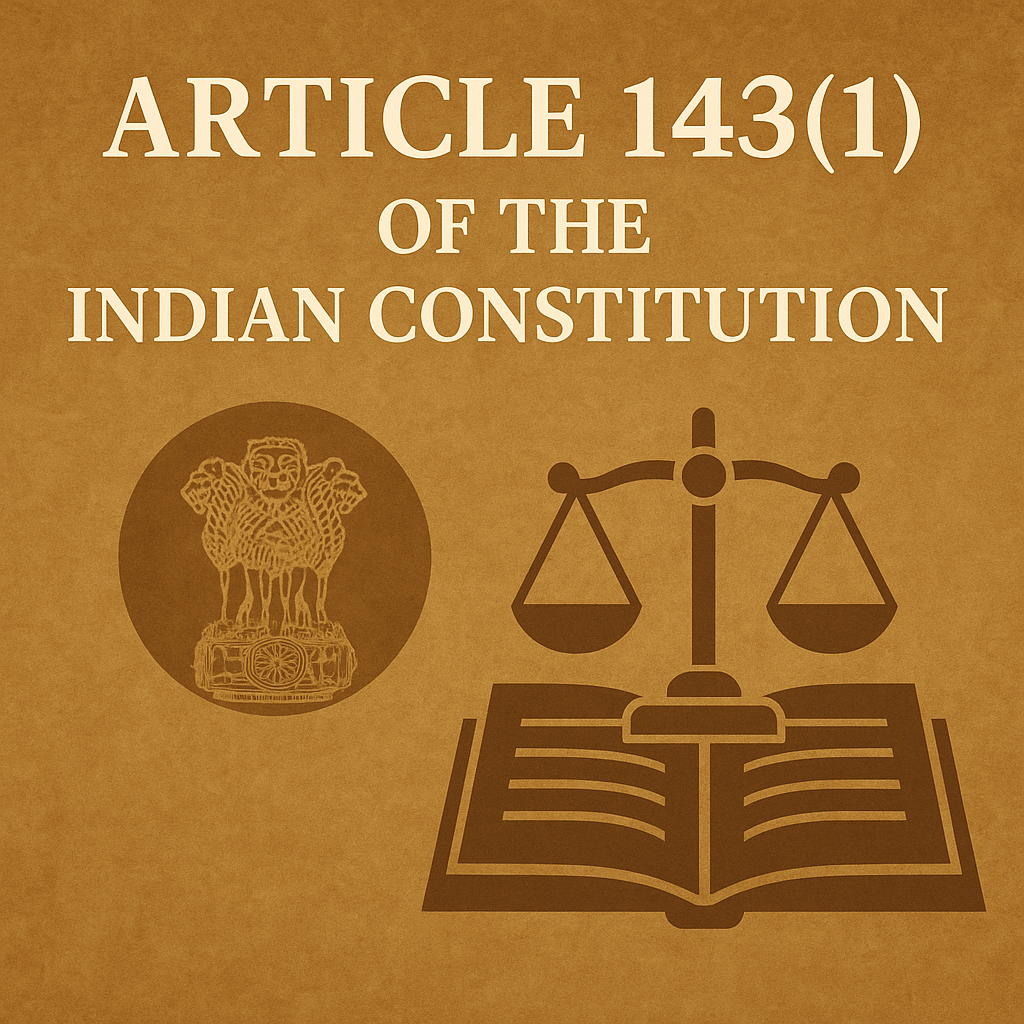Copyright @ 2023 www.digimitr.com. All rights reserved.

Article 143(1) of the Indian Constitution: All You Need to Know
India’s Constitution, a cornerstone of democratic governance, lays out a comprehensive framework for the country’s political and legal system. Among its many provisions, Article 143(1) stands out for its unique role in maintaining the harmony and functionality of India’s constitutional machinery. It empowers the President of India to seek the opinion of the Supreme Court on important legal and constitutional matters. In this article, we dive deep into the “know-hows” of Article 143(1), exploring its scope, significance, process, and impact.
What is Article 143(1)?
Article 143(1) of the Constitution of India states:
“If at any time it appears to the President that a question of law or fact has arisen, or is likely to arise, which is of such a nature and of such public importance that it is expedient to obtain the opinion of the Supreme Court upon it, he may refer the question to that Court for consideration and the Court may, after such hearing as it thinks fit, report to the President its opinion thereon.”
In simpler terms, this provision allows the President to consult the Supreme Court on matters of public importance that involve complex legal questions.
Purpose of Article 143(1)
The primary objective of Article 143(1) is to:
- Prevent constitutional crises by allowing early legal clarity.
- Aid executive decision-making with authoritative legal opinions.
- Ensure smooth functioning of the government in areas where constitutional provisions may appear ambiguous.
- Promote harmony among organs of government, particularly the executive and the judiciary.
Key Features of Article 143(1)
- Discretionary Power: The President has discretion to refer a matter to the Supreme Court. This is usually done on the advice of the Council of Ministers.
- Advisory Jurisdiction: The Supreme Court exercises advisory jurisdiction under Article 143(1), distinct from its regular judicial functions.
- Non-binding Nature: The opinion provided by the Supreme Court is not binding on the President or the Government, but is typically given great respect and followed.
- Matters of Public Importance: The subject referred must be of significant legal and public importance. Not all matters qualify.
- No Adversarial Proceedings: Unlike regular court cases, advisory opinions under Article 143(1) do not follow the traditional format of one party suing another. The Court may invite interested parties or legal experts to assist in the proceedings.
Historical Invocations of Article 143(1)
Over the years, Article 143(1) has been invoked sparingly, only in situations demanding serious constitutional clarity. Some landmark references include:
- In re Berubari Union (1960): The President sought the Court’s opinion on whether a part of Indian territory could be ceded to Pakistan under a treaty. The Supreme Court ruled that such a transfer would require a constitutional amendment.
- Special Reference No. 1 of 1974 (Kesavananda Bharati case review): The President asked whether the Supreme Court’s ruling in the Kesavananda Bharati case (regarding the Basic Structure Doctrine) was binding. The Court declined to revisit the decision.
- Special Reference No. 1 of 1993 (Rama Janmabhoomi-Babri Masjid): The President referred the question of whether a Hindu temple existed at the disputed site in Ayodhya. The Court declined to answer, stating that it was not a purely legal question.
- Special Reference on Cauvery Water Dispute (1991): The President asked for an opinion on the implementation of the Cauvery Water Disputes Tribunal’s award. The Court provided guidance on the matter.
Limitations of Article 143(1)
- Not Justiciable: The President’s decision to make a reference under Article 143(1) cannot be challenged in court.
- Not a Substitute for Legislation: It is meant for legal clarity, not policy-making.
- Time-Consuming Process: The Court may take considerable time to deliberate and deliver its opinion.
Recent Invocation: President Murmu’s Reference on April 8, 2025
On April 8, 2025, the Supreme Court delivered a landmark judgment in the case of State of Tamil Nadu v. Governor of Tamil Nadu, addressing the prolonged delays by Governors in granting assent to bills passed by state legislatures. The Court ruled that such delays were unconstitutional and set specific timelines for Governors and the President to act on bills, including the concept of “deemed assent” if no action was taken within the stipulated period .
In response, President Droupadi Murmu invoked Article 143(1) on May 13, 2025, seeking the Supreme Court’s advisory opinion on 14 critical questions arising from this judgment. The questions pertain to the constitutional powers and discretion of the President and Governors under Articles 200 and 201, the justiciability of their actions, and the extent of the Supreme Court’s powers under Article 142 to impose timelines or grant deemed assent .
This move underscores the significance of Article 143(1) as a tool for resolving complex constitutional issues and maintaining the balance of power among the executive, legislature, and judiciary.
Relevance Today
In an era where constitutional interpretation often becomes central to governance—be it on issues of federalism, religious rights, or electoral processes—Article 143(1) serves as a peaceful bridge between the executive and the judiciary. It ensures that democratic values are preserved, and arbitrary governance is avoided, by encouraging legal consultation before action.
Conclusion
Article 143(1) of the Indian Constitution embodies the foresight of the Constitution’s framers. It offers a mechanism through which the President, representing the executive head of state, can proactively seek the wisdom of the judiciary on complex matters. Though advisory in nature, the Supreme Court’s opinions under this provision hold great persuasive value and have contributed significantly to the development of constitutional law in India.
For lawmakers, administrators, and citizens alike, understanding this article is key to appreciating how India’s constitutional framework promotes checks and balances, dialogue, and good governance.
Have more questions about the Indian Constitution? Browse our Legal Insights section for detailed guides, simplified explanations, and expert analysis.


